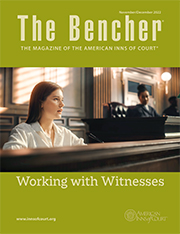Don’t Sleep on PACER as a Tool for Legal Research
The Bencher | November/December 2022
By Raffi Melkonian, Esquire

 Most lawyers are familiar with the common tools of legal research. Westlaw and LEXIS and other commercial databases provide caselaw research for in-depth Boolean searching. A recent addition to the lawyer’s quiver, Google Scholar, provides the fastest research tool, bar none. Everyone knows to start research in unfamiliar fields with a general internet search. Often, a simple keyword search will unearth a useful article or practice guide.
Most lawyers are familiar with the common tools of legal research. Westlaw and LEXIS and other commercial databases provide caselaw research for in-depth Boolean searching. A recent addition to the lawyer’s quiver, Google Scholar, provides the fastest research tool, bar none. Everyone knows to start research in unfamiliar fields with a general internet search. Often, a simple keyword search will unearth a useful article or practice guide.
One technological tool that some lawyers underuse is PACER, the federal courts’ electronic filing system. With some imagination, PACER can be an extraordinarily powerful national database of sample motions, briefs, and other procedural filings that can stand in for a large law firm’s brief bank. In my own practice, I start nearly every novel or complicated filing by reviewing precedents on PACER. Although each precedent must be checked carefully for compliance with the rules, this work helps me make sure I am providing documents to the court that look like what the judge expects. As described below, this technique can work both for appeals as well as trial filings.
Trial court documents. Litigators often find themselves filing documents in unfamiliar courts or preparing unusual motions or complex proposed orders. PACER can be a gamechanger. One approach is to work backward from court opinions. Find cases in which the issue was raised. For example, you may need to see the correct filings for appeal from a bankruptcy court to district court, a notoriously complicated task. An opinion search can uncover recent successful appeals. This will lead back to relevant filings to carefully review for context.
Often, finding two or three cases can help flesh out the local practice so that both the spirit and letter of the rules are followed. And when that method fails, an alternative is brute force. If you have access to a docket search engine, that can be used to narrow down possible cases presenting the right issue. Or, it is often sufficient to simply do an internet search of the general concept to find cases in which the problem has arisen. For instance, if you need the filings required to present a partial appellate bond to the district court for approval, a simple search online for that idea, followed by a review of the PACER filings, can prove fruitful.
Appellate court motions and notices. Appellate practice often involves unusual filings not directly covered by the rules. For example, how exactly should one notify the court of a bankruptcy that has consequences for a pending appeal? What should a voluntary dismissal of an appeal look like? How does one file a motion to recall the appellate mandate?
All of these can be found in PACER’s archives in the court of appeal where you are litigating. My normal technique is to search an entire month or two of PACER orders (you can search “court orders” by month in most courts of appeals). I then do a CTRL-F “find” search through the list. Except for the most obscure filings, this method will usually unearth relevant documents quickly. Then the task is just to sort out the ones that are well done to use as research materials.
To be sure, the back-to-front method described for trial court filings is also effective here. Opinions can lead to good documents to review. A quick additional note: Now that the Supreme Court of the United States has updated its technology, the Supreme Court docket is fully online and free to all to peruse. All the certiorari stage documents can easily be researched by finding a granted petition and analyzing the filings.
PACER is not free to use. Each downloaded page costs $.10, with a maximum of $3 per document. Searches too can cost several dollars if there are many results. Given that these are all court documents, there’s a good argument that PACER should not cost anything. And indeed, there have been extensive efforts made in the past several years, both in the courts and in Congress, to make PACER either free or less expensive. Having said that, until policymakers act, an alternative is to use the RECAP system, a service that collates all PACER files bought by members on a free database. In most circumstances, RECAP’s tens of millions of documents will do the trick.
Used carefully, PACER can be a wonderful technological tool to improve your practice. It deserves a prime place on the litigator’s metaphorical bookshelf together with all the other tools at your disposal.
Raffi Melkonian, Esquire, is an appellate partner at the Houston, Texas, law firm of Wright, Close & Barger LLP. He litigates appeals in the state and federal courts of Texas and around the United States. He can be reached at melkonian@wrightclosebarger.com. Melkonian is Master of the Bench member of the Garland R. Walker American Inn of Court.